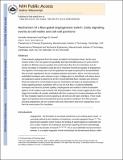Mechanism of a flow-gated angiogenesis switch: early signaling events at cell–matrix and cell–cell junctions
Author(s)
Vickerman, Vernella; Kamm, Roger Dale
DownloadKamm_Mechanism of.pdf (1.645Mb)
OPEN_ACCESS_POLICY
Open Access Policy
Creative Commons Attribution-Noncommercial-Share Alike
Terms of use
Metadata
Show full item recordAbstract
A bias towards angiogenesis from the venous circulation has long been known, but its cause remains unclear. Here we explore the possibility that high interstitial pressure in tumors and the resultant net filtration pressure gradient that would induce flow from the interstitium into the venous circulation or lymphatics could also be an important mechanical regulator of angiogenesis. The objective of this study was to test the hypothesis that basal-to-apical (B–A) transendothelial flow promotes angiogenesis and to investigate potential mechanisms. Macro- and microvascular endothelial monolayers were cultured on type I collagen gels in a microfluidic cell culture device and subjected to apical-to-basal (A–B) and B–A transendothelial flows. Samples were perfusion fixed and analyzed for morphological responses, localization and degree of phosphorylation of certain signaling proteins. Application of B–A, but not A–B flow, to cultured endothelial monolayers was found to promote capillary morphogenesis and resulted in distinct localization patterns of VE-cadherin and increased FAK phosphorylation. These results suggest that B–A flow triggers the transition of vascular endothelial cells from a quiescent to invasive phenotype and that the flow-mediated response involves signaling at cell–cell and cell–matrix interfaces. These results support the hypothesis that transendothelial pressure gradients resulting in B–A flow promotes sprouting angiogenesis and are consistent with early observations that tumor angiogenesis occurs from the venous side of the circulation.
Date issued
2012-05Department
Massachusetts Institute of Technology. Department of Biological Engineering; Massachusetts Institute of Technology. Department of Chemical Engineering; Massachusetts Institute of Technology. Department of Mechanical EngineeringJournal
Integrative Biology
Publisher
Royal Society of Chemistry
Citation
Vickerman, Vernella, and Roger D. Kamm. “Mechanism of a Flow-Gated Angiogenesis Switch: Early Signaling Events at Cell–matrix and Cell–cell Junctions.” Integr. Biol. 4, no. 8 (2012): 863.
Version: Author's final manuscript
ISSN
1757-9694
1757-9708